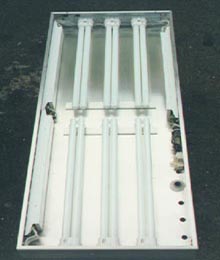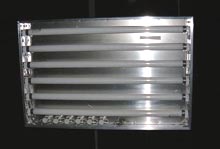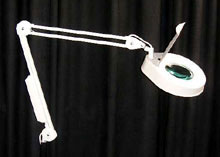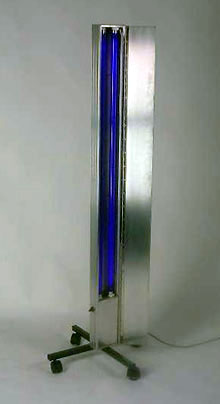|
|
|
|
|
|
|
|
|
|
ISO 3664 - International Standard for artificial light
It has long been accepted that there is a need for an international standard for artificial light sources used in the assessment of colour. Daylight has a broad spectrum but suffers from being variable in both quantity and quality, and most artificial light sources require filtering. CIE discussions led to an agreement to specify two light distributions one CIE Illuminant D.6500K and the other Illuminant D.5000/5400K. In Britain these distributions have been incorporated into BS950 Part 1 (daylight/TLD95 & C95 PLL compact, below) and Part 2 (northlight/TLD96, below), respectively. Phillips are the first company to produce single light sources having light distributions designed to meet the requirements of both parts of this standard, and the new EU standard ISO 3664.
Use of an agreed light source eliminates possible differences of opinion between supplier and client and inconsistent results between different branches of an organisation. It also enables critical assessment of colour to be done at all times, even outside daylight hours when previously this was impossible. It is recommended that clients adopt the same light source for use at all times of the day or night.
|
|
|
|
|
|
 |
|
NEW PLL Colour 95 compact tube - BS950 Part 1.
The new compact PLL Colour 95 (daylight) tubes are superior in light output than conventional tubes. Colour rendering index 98, colour temperature 5300K and giving up to 4,000 lux at 1 metre.
The HB lighthead (left, shown without Perspex diffuser) incorporates this new compact technology. New high frequency electronic ballasts/transformers are very light in weight and so are incorporated inside the lighthead. They also ensure zero flicker comes from the tubes, and unlike conventional copper coil ballasts/transformers they give out very little heat. The lighthead is very light in weight and can be moved from one mounting to another with ease.
|
|
|
|
 |
|
|
|
 |
|
Phillips TLD95 GraphicA - BS950 Part 1 (daylight)
The TLD95 is ideal for restoration and conservation work where 'full spectrum' light is essential, but without the harmful effects of Ultra Violet or Infra Red radiation. It is only 25mm (1in) diameter but will also fit all original CLE luminaires.
This lamp is almost obligatory for the viewing of both originals and reproductions of colour prints and transparencies. The TLD95 GraphicA innovation is a multi-phosphor coated tube, designed specifically to comply with the visible spectrum requirements of BS 950 Part 2 and ISO 3664.
Colour Rendering Index of the TLD95 is 98. Phillips TLD95 is primarily for viewing booths, conservation luminaires and transparency boxes. In addition, the same source should preferably be used for general lighting purposes in the same room to preserve chromatic adaptation. For all critical work, the illumination level should be high: the BS recommends a level of 2200 lux on the test surface in a viewing booth: for transparencies the luminance of the viewing screen should be a minimum of 4000 lux.
|
|
|
|
 |
|
|
|
 |
|
Phillips TLD96 - BS950 Part 2 (northlight)
TLD96 gives good colour rendering on the blues, greens etc, but is weaker on browns and reds. However, if used with another source of illumination such as a Tungsten Halogen or natural daylight they may be useful for certain conservation work. The TLD96 is a new triphosphor tube with improved characteristics. It is only 25mm (1in) diameter but will also fit all original CLE luminaires.
TLD96 complies with the visible spectrum requirements of BS 950 Part 1 and ISO 3664 and has high fidelity colour rendering properties. It is principally intended for critical colour appraisal of samples, of e.g. paints, dyes or textiles and also for general lighting, e.g. in printing works. It is also used where materials are graded by a small difference in colour appearance. Colour matches made under this light source are similar to those made under common phases of North daylight and therefore, the TLD96 can be used in the majority of applications where previously only daylight was reliable. It is important that a reasonably high level of illumination (the BS recommends 750-3200 lux) is maintained over the whole area where matching takes place.
|
|
|
|
 |
|
|
|
|
|
 |
|
Illuminated Magnifier Tubes
A daylight (5400K) tube is available for illuminated magnifiers, this is equivalent to the TLD95 above.
A northlight (6500K) tube is available for illuminated magnifiers, this is equivalent to the TLD96 above.
A Cool White tube (4200K) is available for illuminated magnifiers, this is equivalent to a standard flurorescent tube.
|
|
|
|
 |
|
|
|
|
 |
|
Daylight Bulbs
- Tungsten filament lamp with blue glass envelope
- Life: 500-1000 hours
Spectral Distribution
These lamps emit a cool light with excellent colour rendering properties. They have an enhanced spectral distribution as illustrated in the graph below.
They simulate daylight to a high degree. Natural daylight is normally benchmarked at approximately 5,400° K, but it should be borne in mind that it can vary between 10,000K in winter and 3,000K in summer.
Unlike most enhanced spectrum lighting systems these lamps have virtually no ultra violet content. This is an advantage in many circumstances as UV can often have a harmful effect on certain material (degradation of paint pigments, carpets, textiles, paper, photography etc.).
No Strobing Effect
Daylight bulbs have none of the following side effects caused by fluorescent lighting:
- no flicker, most fluorescent light has some sort of flicker, even though it may not be detectable by the human eye. This is a common cause of migraines and eye strain.
- they light up immediately and do not cause radio or TV interference when switched on.
Available in Bayonet (BC) fitting or Screw (ES)
- 150w BC Daylight approx 5,000K.
- 60w/100w ES Reflector Spots RO80 4,000K.
- 60w/75w BC or ES Daylight approx. 4,000K.
- 100w BC or ES Daylight approx 5,000K.
|
|
|
|
 |
|
|
|
 |
|
Daylight Compact Bulb
Range of compact fluroescent lamps colour corrected to 6,000K. Energy saving 20W fitting equivalent to 100W Daylight Bulb, but with low heat output and longer life. Available in ES (screw) or BC (bayonet) fitting.
|
|
|
|
 |
|
|
|
 |
|
Blacklight UV Tubes
The range of CLE UV handlamps are all fitted with the new Blacklight Longwave tubes, radiating in the 355-360nm region (UVA), but with an integral filter to absorb the visible and short wave light. These are ideal for investigative and photographic work on works of art, including textiles, oil paintings, water colours, archives, stamps, ceramics and sculpture. Conservators, historians and dealers have used these to detect overpainting, previous restoration, imperfections, forgeries and repairs.
The tubes are totally safe for use without protection, but special spectacles and goggles are available to enhance vision and reduce any 'glare' (see page 10). Separate data sheets are available on UV/BLB tubes, UV detection & use.
Special tubes can be supplied for bleaching paper, destruction of spores & mould growth, adhesive setting etc. (data on request).
BLB UV tubes are available for Fluorescent Task lights and UV vertical luminaires. A range of black carry cases are available which have a foam lining to allow other small instruments to be inserted.
|
|
|
|
 |
|
|
|
|
|
|
|
|





